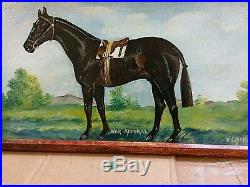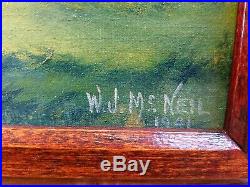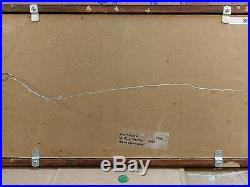
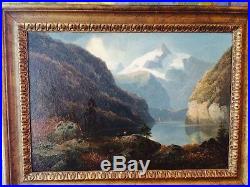
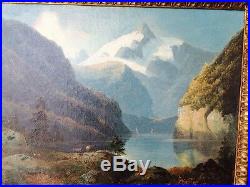
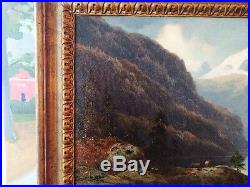
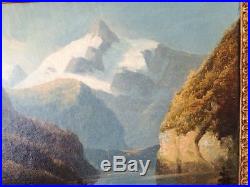
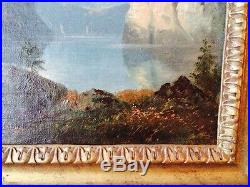
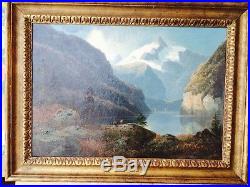
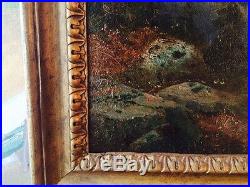
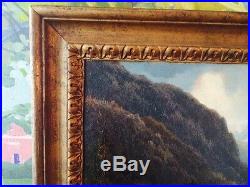
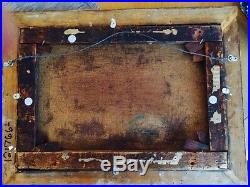
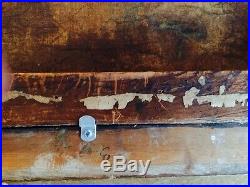
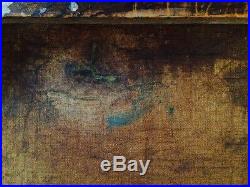

Painting BY DAVID JOHNSON. THIS PAINTING IS TITLED WHITE MOUNTAINS 15X21 inches. IT IS SIGNED ON STRETCHER IN BACK LOWER STRETCHER. There is the name Johnson and White Mountains on lower Stretcher. David Johnson is one of America’s well-known famous Hudson River School artists. Known for: landscape, some portrait, and still-life painting. BIOGRAPHY for David Johnson. 1827 (New York City). 1908 (Walden, New York). Self portrait – David Johnson – Self Portrait. Landscape, some portrait, and still-life painting. This biography from the Archives of AskART. A landscape painter based in New York City and associated with the second generation of Hudson River School painters, David Johnson was noted for his ability to delineate accurately rock formations and foliage. He was especially influenced by the work of Hudson River painters Jasper Francis Cropsey, John Casilear, and John Frederick Kensett. He also painted an occasional still life. Johnson was born and raised in New York City, but little else is known about his early life. He studied briefly with Cropsey but said that his best teacher was nature, which he utilized in his paintings from his frequent trips to the Hudson River Valley, especially the areas around West Point and Fort Putnam. He painted his first nature studies in 1849, and that year first received public acclaim for his work exhibited at the National Academy of Design and the American Art Union. In 1860, he was elected a full Academician. Primarily he painted in the Northeast, doing views of the Catskills, Adirondacks, Lake George, the Hudson River and the White Mountains, where he worked in the early 1850s with a colony of artists around North Conway. His early landscapes tend to be panoramas, rock studies, or forest interiors. In the middle of his career, he adopted a more luminist style and did tranquil marine scenes such as flowing rivers, and his later work showed Tonalist influence of the French Barbizon School with pastoral subjects. It is written that this period in his career was not much distinguished and that Influenced by the barbizon style, his work became monotonous and less articulate. (Zellman 223) In the 1880s, his reputation began to diminish, and by the time he died his work was virtually unappreciated. Many years later, it was re-discovered by scholars who appreciated his great skills of naturalist documentation. Sources include: Michael David Zellman, 300 Years of American Art John Howat , The Hudson River and Its Painters. David Johnson (18271908) By the end of the nineteenth century David Johnson had gained a reputation as the best painter of trees in America and acquired the nickname the American Rousseau, in reference to Barbizon School landscape painter Theodore Rousseau. (1) Best known for landscape paintings and his knowing naturalist eye, Johnson depicted scenic views in Connecticut, Massachusetts, Maine, New Hampshire, New Jersey, New York, Virginia, and the far West. (2) He also was an accomplished draughtsman and portrait painter. Johnson was born in New York City in 1827. Despite his claim that he was self-taught, archival records indicate that he registered for two years (18451847) at the antique school of the National Academy of Design. He studied briefly with the Hudson River artist Jasper F. He also may have received some instruction from his older brother Joseph Hoffmann Johnson (18211890), who painted portraits, and from his study of art books, which he is known to have borrowed from the National Academy of Designs library. From the start of his career, Johnson was associated with the second generation of Hudson River artists, and he completed his first dated landscape in 1849 in the company of two prominent Hudson River painters, John F. Kensett (18161872) and John W. (3) This group of artists is now best known for the development of Luminism, a landscape style characterized by atmospheric light effects, tranquil compositions, and precise renderings of nature. Johnson experimented with a variety of British, French, and American styles, and he proved adept at developing and altering his style to suit the changing tastes of the time. By the late nineteenth century, Americans had begun to favor and to collect landscapes by French Barbizon painters, including Rousseau and Narcisse Diaz de la Pena. Such patrons preferred general, pastoral scenes to depictions of identifiable American natural landmarks. By adopting Barbizon formats in the 1870s, the versatile Johnson found a second life as a painter. He revisited the Hudson River imagery he had painted so meticulously in his early career with a more intimate, free manner. By 1850, Johnson was exhibiting regularly at the National Academy of Design in New York, where he became an associate in 1860 and a full academician the following year. His works also appeared in exhibitions at other major American art centers, including Chicago, Boston and Philadelphia, and Scenery on the Housatonic was shown at the Paris Salon of 1877. He died in Walden, New York, in 1908. After decades of relative obscurity for Hudson River artists, scholars rediscovered Johnson in 1980s and began documenting his life and work. Notes (1) What our artists are doing, The Studio (New York) IX (28 April 1894), 1, as quoted in Gwendolyn Owens, Nature Transcribed: The Landscapes and Still Lifes of David Johnson (18271908) Ithaca: Herbert F. Johnson Museum of Art distributed by University Press of New England, 1988, 53. (2) Owens, Nature Transcribed , 17. (3) An inscription on the back of Johnsons first nature study, Haines Fall, Kauterskill Clove (1849), indicates where, when and with whom he painted it. The exact brushwork of Mr. David Johnson, An American Landscape Painter, 18271908, American Art Journal 12, no. 4 (autumn 1980), 33. Biography from Karen L. North, Private Art Dealer. David Johnson was a talented member of the second generation of Hudson River School artists. He was primarily self-taught with no formal artistic training, except for a few lessons with artist Jasper Cropsey. In addition to his early training with Cropsey, Johnson also painted with fellow Hudson River painters, John F. Kensett and John W. Casilear, who also helped develop Johnsons artistic skills. Johnson became a keen observer of nature, depicting with detail rocks, water, plants and trees. His work was greatly admired by collectors and artists alike during the nineteenth century. As artist, Benjamin Champney once pointed out: He has shownwhat such conscientious study may lead to as he has quietly and modestly attained a very high rank as one of the leading landscapists of New York. Johnsons often signed his paintings with distinctive as the intertwined initials. The main characteristic that all of the artists paintings shared was noted by one nineteenth century critic as the exact brushwork of Mr. Johnson often signed his name and recorded the locations of paintings on the reverse of his canvases, panels and boards. The primary locations for many of his compositions were the Hudson River Valley, the White Mountain region in New Hampshire, the Androsoggin River in Maine, and scenes from Vermont, New Jersey and Connecticut. The artist exhibited his work frequently at venues including The American Art Union, The Brooklyn Art Association, Pennsylvania Academy of Fine Art, The Paris Salon of 1877 and the National Academy of Design. He became a full member of the National Academy of Design in 1861. His paintings can be found in many museums and private collections. The Exact Brushwork of Mr. American Art Journal, Vol. 39, quoted from Benjamin Champney, Sixty Years Memories of Art and Artists Woburn, Mass. (Autumn 1980); p 62, from an anonymous review of an exhibition of Thomas B. Clarkes collection, New York Times , December 28, 1883, p. The item “Oil on canvas David Johnson HUDSON RIVER SCHOOL White Mts. Listed artist” is in sale since Friday, January 2, 2015. This item is in the category “Art\Paintings”. The seller is “johnjay5″ and is located in Garden City, New York. This item can be shipped to United States.
- Original/Reproduction: Original
- Listed By: owner
- Signed?: Signed
- Medium: Oil
- Subject: Landscape
- Style: Realism
- Size Type/Largest Dimension: Medium (Up to 30in.)
- Date of Creation: 1800-1899
- Region of Origin: White Mountains, New Hampshire, United States


